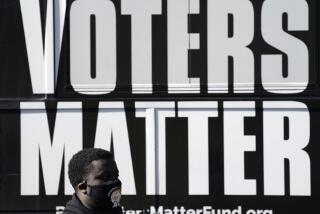Gore Can’t Count on Electoral Tradition
- Share via
JACKSON, Tenn. — The crowd was enthusiastic, the weather warm, and the setting green and graceful when Al Gore stopped by the local fairgrounds here for a rally Wednesday afternoon.
But any skeptics in the crowd could still be forgiven for wondering whether the vice president was entirely sincere when he told the audience, “It’s great to be home in Tennessee.”
In fact, probably the last place Al Gore wanted to be less than two weeks before the presidential election was his home state of Tennessee. His presence, on a day when campaign aides would undoubtedly have preferred to be in a more traditional swing state, was an uncomfortable reminder that Gore hasn’t yet been able to lock down a state that he represented in Congress for more than 15 years.
And Tennessee is hardly alone: From the Pacific Northwest through New England, from the Southwest through the Midwest, Gore is struggling to hold on to states that Democrats had come to consider part of their base in reaching the 270 electoral votes needed for victory. “He simply has been unable to put away states that have gone Democratic not just in the 1990s but in some cases well back into the 1980s and 1970s,” GOP pollster Whit Ayres said.
Gore’s difficulties are part of a wider phenomenon: An unusually large number of states this year are close, mostly because both Gore and George W. Bush are relatively centrist candidates who can appeal across a broad ideological and geographic spectrum. Texas Gov. Bush, the GOP nominee, is having problems securing parts of his own base, particularly in Florida, which Republicans dominated for a quarter-century until Bill Clinton captured it in 1996. A poll this week in Colorado, another Republican bastion, gave Bush just a scant 4-percentage-point lead.
But Gore is facing a much broader and sustained challenge to his electoral foundation: To varying degrees, Bush is competitive in almost two dozen states that Clinton won in 1996, including six states that Democrats have carried in each of the last three presidential elections.
In one sense, this battlefield reflects only the obvious: Bush can’t win without recapturing states that Clinton carried en route to winning 379 electoral votes in 1996. But Gore’s struggles in states as varied as Washington, Oregon, Wisconsin, Louisiana and West Virginia also may illuminate the difficulty he’s having holding electoral ground that Clinton captured.
“It’s a reversion to the more traditional electoral college pattern that we saw in the 1970s and 1980s,” Ayres said.
In many of these states, Gore is being squeezed between defections on the left to Green Party nominee Ralph Nader and Bush’s furious effort to portray the vice president as a pre-Clinton liberal. And that vise is making Gore sweat.
About one-fifth of the Clinton states that Bush is contesting are legitimate swing states up for grabs in every election: New Mexico, Michigan, Missouri, Pennsylvania and Ohio. Another two Western states now leaning back toward Bush--Nevada and Arizona--are states any Democrat is unlikely to carry in a close contest.
And Gore appears to have stabilized his position in two mega-states at the heart of Clinton’s electoral coalition. Public polls this week showed Gore leading by 7 points in California and 10 points in Illinois; senior Republicans acknowledge victories there are unlikely, but the Bush camp felt optimistic enough to announce Thursday that it would launch an advertising push in both states.
Breaking Down the New Swing States
But even after these states are excluded, Gore is still laboring, to varying degrees, in 13 other states that Clinton carried in 1992 and 1996. These states break down into three distinct categories:
* The Dukakis Six: Gore has been unable to put away Bush in six states that not only voted for Clinton twice but also backed Michael S. Dukakis in 1988: Oregon, Washington, Wisconsin, Iowa, Minnesota (which hasn’t voted for a Republican presidential nominee since 1972) and West Virginia (which the Democrats have lost only twice in the last 40 years). Bush’s prospects look best in Wisconsin and Oregon, and Gore is strongest in Iowa and Washington, but the vice president today can’t entirely count on any of the six, which offer a combined 51 electoral votes.
Local issues are a factor in each state. Bush, for instance has gained ground by painting Gore as an environmental extremist in West Virginia (on coal), Oregon (on timber) and Washington (on whether to breach Snake River dams to protect endangered salmon).
But some common threads run through these states. Apart from Iowa and West Virginia, these are the states where Nader is probably hurting Gore the most; recent public polls in Oregon and Minnesota gave Nader 10% and 8% of the vote, respectively--in each case more than double Bush’s lead over Gore in the surveys.
“If we could have 4 or 5 or 6 points of Nader votes, we would be out of the woods in most of what we are calling the Dukakis states,” Democratic consultant Bill Carrick said.
Reflecting that perspective, the National Abortion and Reproductive Rights Action League, a group that supports legalized abortion, announced this week that it would run $500,000 in television ads in Oregon, Minnesota and Wisconsin warning that a vote for Nader could give Bush a victory that would allow him to place anti-abortion justices on the Supreme Court.
But other analysts say Gore’s problems in the Dukakis Six run deeper. These states also share in common significant rural populations. (In all but Washington, at least 30% of the population is rural; in Washington, it’s about 25%.) In 1992 and 1996, Clinton held down the traditional GOP advantage in farm country. But this year, “Bush is clobbering Gore in rural America,” GOP pollster Linda DiVall said. Depending on the survey, Bush leads Gore among rural voters between 10 and 20 percentage points.
Both short- and long-term factors may explain that problem. Democrats note that the same issue contrasts on gun control, abortion and the environment that are helping the party gain ground in moderate suburban communities are costing them support in more socially conservative rural areas. This year that process is being accelerated by dissatisfaction over the farm economy and a values-based backlash against Clinton, analysts in both parties believe.
A final twist compounds Gore’s problem. Just as in states all over the country, Bush in these six is competing more effectively than Dole for swing suburban voters, particularly on the issue of education. In most of these states, Gore so far has not yet made Bush pay a significant price in suburbia for the conservative positions on the environment and social issues that are helping him in rural communities.
“I don’t think they [the Gore campaign] have done a real good job at that yet,” says Tim Hibbits, an independent pollster in Oregon.
* Small Cracks: The Northeast and Mid-Atlantic have been Gore’s most solid regions. But small cracks in the fortress have emerged. After early uncertainty, Gore appears to have regained a comfortable edge in Maine. But New Hampshire, which Clinton carried twice, is now uncertain; Democrats say they are confident about holding Delaware, but Republicans still hold out hope there. In an ordinary year, none of these three states--which offer only 11 electoral votes combined--might matter much; but this year, both sides are clawing for every bit of ground.
* The Reverting South: As a Southern Democrat, Clinton slowed the South’s generation-long realignment toward the GOP in presidential elections. But he did not reverse the current, and this year the tide is running high again: Gore may be lucky to hold any of the Southern states Clinton carried in 1992 or 1996.
Georgia, which went for Clinton in 1992 but for Dole in 1996, seems secure for Bush. Bush also appears to have a lock on Kentucky, which Clinton narrowly carried twice. Republicans feel confident about Louisiana--another energy-producing state where Bush has used Gore’s environmental positions against him. Both sides put Arkansas (where two-thirds of the population is rural) on the knife’s edge.
Then there’s Tennessee. Gore’s been successful all eight times he’s appeared on the ballot here, and he benefits from family and political ties that stretch back through the career of his father, the late Sen. Albert Gore Sr. But Republicans maintain their private polling this week shows Bush leading in the state, and Democrats acknowledge it’s too tight for comfort. Noting that Clinton and Gore carried the state by only 2.4 percentage points in 1996, one senior Democratic strategist said: “I will take 2 points this time.”
Calculating the Florida Factor
The great exception to this pattern is Florida, which, politically, is beginning to behave less like a socially conservative Southern state than a moderate suburban battleground, such as New Jersey or Ohio. Here Bush hasn’t been able to put away Gore: The latest public polls diverge, with one released Wednesday showing a 5-percentage-point Bush lead and two others conducted this week giving Gore a 4-point edge.
If Gore swipes Florida’s 25 electoral votes, he would be able to survive more than a few unexpected defections in other states Clinton carried. But Democrats will surely feel more confident if they head into election day knowing that Gore has secured enough of his base elsewhere that he doesn’t need to capture Florida to win.
More to Read
Get the L.A. Times Politics newsletter
Deeply reported insights into legislation, politics and policy from Sacramento, Washington and beyond. In your inbox twice per week.
You may occasionally receive promotional content from the Los Angeles Times.










